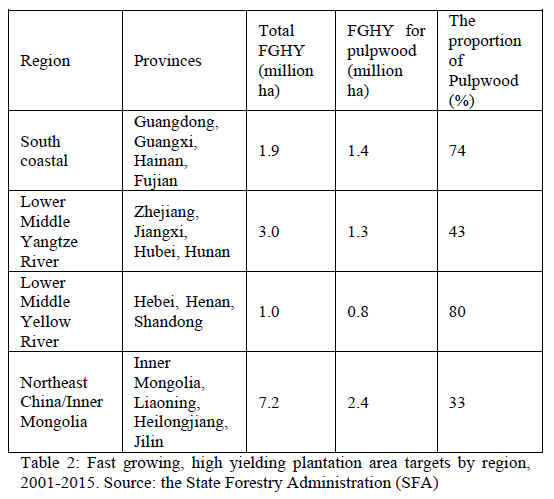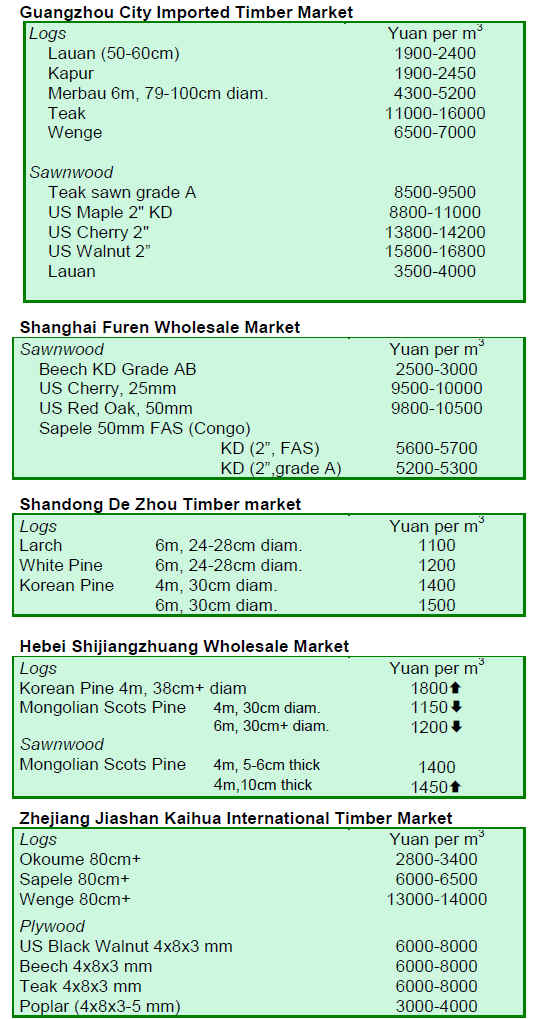US Dollar Exchange Rates of 31th August. 2009
China Yuan 6.8302
Report from China
Status of China¡¯s plantation forests
According to the China¡¯s Sixth Forest Inventory Report
(covering 1999-2003), China¡¯s forested area was 175
million hectares with the forest stock volume at 12.45
million m³. Forest coverage was estimated at 18%. Of the
total forested area, the area of tree plantations in China
was 53 million hectares. China¡¯s plantation area was
expected to expand rapidly due to high domestic demand.
Plantations play an important role in restoring and
rebuilding the total forest ecosystem. They supply wood
and non-wood products and help improve the ecoenvironment.
The country¡¯s plantations contain an
estimated 1.5 billion m³ of standing volume and account
for around 12% of the county¡¯s total forest volume. Of the
total plantation area, the forest area was 32.29 million
hectares (60.64% of the total plantation area); cash tree
crops, 19.31 million hectares (36.26%); and bamboo
plantations, 1.65 million hectares (3.1%).
Of the standing forest plantations, the productive
plantation area was 23.18 million hectares with a standing
volume of 1.15 billion m³. Protective plantations covered
an area of 8.12 million hectares and fuelwood plantations
covered an area of 483,300 hectares (4 million m³ by
volume). The area of forest for special uses is 514,600
hectares, with a forest volume of 31.12 million m³.
Plantations for timber production accounted for the largest
area and volume and these plantations account for around
70% of the total plantation area.
Plantation resources have been mainly distributed in the
south of the country and mainly collectively owned
forests. The following five provinces (regions) account for
the bulk of the plantation areas, namely Guangxi,
Guangdong, Hunan, Fujian and Sichuan. The total area
and volume of these five provinces accounted for 37.2%
and 41.76% of the country¡¯s total plantation area and
volume, respectively. The main plantation species were
Chinese fir (Cunninghamia lanceolata), Masson¡¯s pine
(Pinus massoniana) and poplar (Populus spp.), these three
species accounting for some 60% of all plantation areas in
the country.
1.1 Tropical forests
Distribution and types of tropical forests
China¡¯s tropical forests have been distributed across parts
of Yunnan, Guangxi, Guangdong and Hainan provinces
and the southern most tip of the Tibet Autonomous Region
where there is a unique ecosystem influenced by warm air
flows reaching deep inland up the Yalu Tsangpo River
valley. The total area of tropical forest region in China was
26.49 million hectares, accounting for less than 3% of the
country¡¯s land area. Tropical seasonal rainforest has been
the predominant forest type of tropical forest in China but
there are also areas of tropical evergreen broadleaved
forests, tropical rainforests and mangrove forests.
According to the 6th national forest inventory, forestry
land area in the forest regions is 14.24 million hectares,
accounting for 53.77% of the total forest regions. Of the
total 14.24 million hectares, the forested area was 10.17
million hectares, open forest land area 232,600 hectares
and brush land area 1.39 million hectares. The total
volume of standing timber in the tropical forest was some
952 million m³, accounting for over 7% of the country¡¯s
total standing timber volume. Of the total 952 million m³,
the forest volume was 902.87 million m³, accounting for
94.9% of the forest region¡¯s standing timber volume. The
open forest volume was 5.25 million m³. Scattered timber
volume was 35.94 million m³ and the volume of the ¡®fouraround¡¯
plantations around houses, rivers, villages and
roads was 7.52 million m³, accounting for 0.79%.
In the tropical forest regions, the area of natural forest was
5.7 million hectares, with a standing volume of 820
million m³, and natural forest accounts for 56% of the
forested land area. In natural tropical forests, the forest
stand area was 5.65 million hectares, with cash tree crops
covering 9,400 hectares and bamboo forest amounting to
50,400 hectares. The plantation area in the tropical zone
amounted to 4.47 million hectares. In the plantation area,
the stand area is 2.02 million hectares, with cash tree crops
consisting of an area of 2.36 million hectares and bamboo
forest area covering 92,400 hectares.
The Chinese government divides tropical forests into three
types: commercial forests, ¡®beneficial¡¯ forests and dual
purpose forest. The proportions of the various forest
categories are shown in Figure 2.

1.2 The challenges of and opportunities for China¡¯s
plantation development
Over several decades, China¡¯s plantation area has grown
to 53 million hectares, making China¡¯s plantations the
largest in the world. However, most plantations have yet to
reach full maturation (about 77.4%), with the volume per
unit area reaching only 46.59 m³ per hectare,
corresponding to 55% of the national stand average level.
In national plantations, Chinese fir, Masson¡¯s pine and
poplars accounted for 59% of the total area and the
proportion of conifers was 71%. Foresters point to the
risks of concentrating plantations with just a few species
and point out that this increases the risk of pests and
diseases, a potential decline in land fertility and a likely
decline in bio-diversity all of which are unfavorable to
healthy forest development.
Chinese government promotes sound policies for its
plantation-based wood pulp industry
The Chinese government has been aggressively promoting
development of a domestic wood pulp industry, integrated
with plantation-based fiber supply and downstream paper
production. It has been doing so by providing discounted
loans from state banks, fiscal incentives and capital
subsidies for establishment of fast growing pulpwood
plantation.
During the last 15 years, China has emerged as a leading
player in the global pulp and paper sector. China has
accounted for more than 50% of the world¡¯s overall
growth in paper and paperboard production since 1990,
when the country produced an aggregate of 13.7 million
tons across all grades. With 84.0 million tons of paper and
board production in 2008, China is now the world¡¯s largest
producer, exceeding the US.
Historically, China¡¯s domestic pulp industry has been
structured around large numbers of small-scale mills
relying heavily on non-wood fibers, including bamboo,
bagasse, wheat straw and other agricultural residues. Much
of the new paper and board capacity now being produced,
however, relies on recovered paper obtained from both
domestic sources and imports. Demand for wood-based
pulp has also grown substantially in recent years,
particularly as China¡¯s production of printing and writing
paper and other high grade papers has expanded.
In order to meet the huge demand for timber, China has
energetically developed plantation resources. There are
three types of plantations in China, fast-growing and high
yielding plantations, pulp paper plantations and industrial
timber plantations. On the one hand, Chinese government
has adopted a variety of policy measures to promote the
development of domestic plantations. The government has
offered significant financial incentives and capital
subsidies to support priority plantation projects. The
Chinese government has also sought to encourage foreign
investment.
The fast-growing plantation programme covers four
priority geographic regions, the southern coastal region,
the lower and middle reaches of the Yangze River, the
lower and middle reaches of Yellow River and the
Northeast China/Inner Mongolia Autonomous region. In
aggregate terms, the largest area allocated for pulpwood
plantation development is in the Northeast China/Inner
Mongolia Aunomous Region, where 2.4 million hectares
of plantation are planned to produce pulpwood fiber (see
Table 2). However, in the South Coastal and Yellow River
region, the areas planned for pulpwood are substantially
larger relative to the total area allocated for fast growing
high yielding (FGHY) plantations than they are in the
other two regions. China target is to plant 13 million
hectares of FGHY forest by 2015.

According to the State Forestry Administration, the
government has structured the FGHY programme around
99 priority projects, which are eligible to receive
subsidized financing to encourage fast growing plantation
development. Thirty-nine of these projects involve the
development of pulpwood plantations. Under the
government¡¯s plan, development of these plantations will
be subsidized through loan interest subsidies, discounted
loans from state banks and extended repayment periods.
Specifically, the State Forestry Administration has
indicated financing for priority fast growing plantation
projects will come from four sources:
1) State-owned banks will provide 70% of the overall
financing for the FGHY programme or
approximately USD6.1 billion in the form of
discounted loans to state forest farms, private sector
plantation companies and farmers¡¯ cooperatives. The
China Development Bank and the Agricultural Bank
of China in particular will provide loans with reduced
interest rates and an extended 10-15 year repayment
period;
2) The Ministry of Finance will allocate 20% of the
FGHY programme¡¯s total financing, or
approximately USD1.7 billion, through loan interest
subsidies;
3) Local governments are responsible for providing 3%
of the program¡¯s financing;
4) Plantation companies receiving the discounted
government finance are responsible for contributing
7% of their projects¡¯ financing from their own funds
or commercial sources.
In many parts of China, delivered wood costs are also
substantially higher than those found in more efficient
pulp producing countries. Delivered wood costs in South
China currently range between USD20-25 per ton for
eucalyptus from state forest farms and USD3-40 per ton
for eucalyptus grown on collectively owned land that is
either managed by farmers¡¯ cooperatives or leased from
local communities by plantation companies. By contrast,
pulp producers in Indonesia are reported to pay USD12-25
per ton for ¡®mixed tropical hardwoods¡¯ harvested from
natural forest and for plantation-grown Acatia mangium.
In Brazil, where highly efficient eucalyptus plantation
have been developed near major mill sites, some producers
report delivered wood costs as low as USD5-15 per ton.
The relatively higher wood costs in China can generally be
attributed to substantial cost involved in leasing land, high
transport costs resulting from poor infrastructure and
dispersed nature of small-holder plantation sites and the
need, in many areas, for heavy fertilizer inputs to
compensate for poor soil conditions. In the northwest part
of Hainan, leasing land that is not suitable for agriculture
costs approximately USD55-100 per hectares per year
depending on the location, topography and soil fertility.
Land lease prices on the provincial east coast are not less
than USD130 per hectares per year since soils are more
fertile and there is more demand for agricultural land.
Investors eye higher returns from teak plantations
Teak is fast growing precious species and can reach
heights of 8.31 meters in three years. Teak is very popular
to be produced into high grade furniture and floors.
However, natural teak forests have become extinct in
China. China imports a large volume of teak from foreign
countries every year. The price for a 30-50 cm diameter
teak log is RMB7,000 to 10,000 yuan per m³. For teak log
more than 50 centimeters in diameter, the price can reach
RMB10,000 to 15,000 yuan per m³.
The Chinese government has adopted appropriate policies
to encourage both domestic and foreign investment in the
development of teak plantations in China. The conditions
of soil and climate in southern regions of China like
Guangdong, Guangxi, Hainan and Yunnan are suitable for
planting teak. According to local experts¡¯ analysis, RMB
55,000 yuan per mu of returns can be gained from
investing in plantation teak in Guangdong Province over a
15 year period.

|